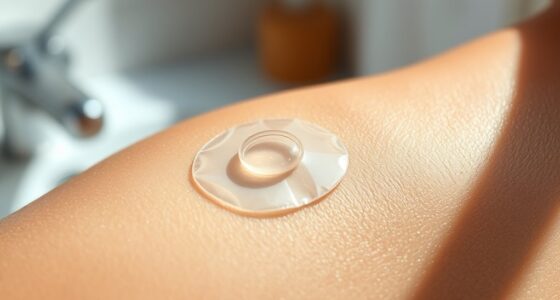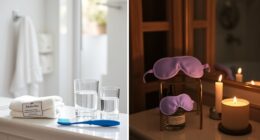Pimple patches should be worn for about 4 to 8 hours for the best results. If you have a whitehead, aim for 6 to 8 hours to maximize absorption. You can wear them overnight, but make sure to check if they’ve turned white or cloudy; that’s a sign they need replacing. While pimple patches can be effective, there are important considerations for usage that you might want to explore further.
Key Takeaways
- Pimple patches should ideally be worn for 4 to 8 hours for optimal results.
- For whiteheads, aim for 6 to 8 hours for maximum absorption benefits.
- Extended wear can be 8 to 12 hours, with some patches lasting up to 24 hours.
- Replace patches when they turn white or cloudy, indicating saturation.
- Always ensure the area is clean and dry before applying for best adhesion.
Understanding Pimple Patch Wear Time

When you’re using pimple patches, it’s important to know how long to keep them on for the best results. These patches are designed for several hours, and many users find overnight wear effective.
They create a moist environment that helps your skin heal while absorbing excess fluid and impurities from pimples, reducing both redness and size. While you can wear them for up to 24 hours, keep an eye on the patch for saturation; once it’s saturated, it loses effectiveness.
Regularly checking guarantees you get ideal results. Remember, pimple patches not only target specific breakouts but also act as a protective barrier against dirt and bacteria, making them a smart addition to your skincare routine.
Ideal Duration for Effective Treatment
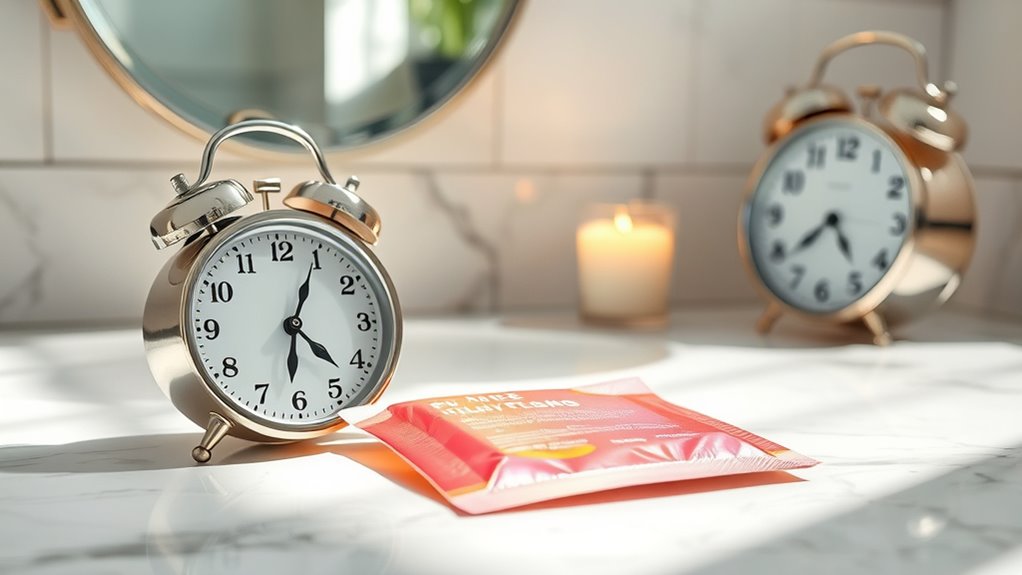
To achieve the best results with pimple patches, knowing the ideal duration for effective treatment is key. Typically, you should leave patches on for 4 to 8 hours to absorb impurities and reduce inflammation. For whiteheads, aim for the full 6 to 8 hours for peak fluid absorption. If you’re dealing with cystic acne, longer wear might be necessary as these patches act as a protective barrier. Some patches can even be worn for up to 24 hours to maximize healing and minimize redness. Keep an eye on the patch; it turns white or cloudy when it’s absorbed its maximum capacity, signaling that it’s time to remove it. This hydrocolloid technology creates a moist environment that speeds up healing and prevents scabs and scars. Adjust your wear time based on your skin type and the severity of the blemish.
Overnight Use: Benefits and Considerations

Using pimple patches overnight offers several benefits. They speed up healing by continuously absorbing impurities and reduce redness, making blemishes less noticeable by morning. Patches also protect against picking, which minimizes scarring risk. The moist environment they create promotes faster healing and prevents scabs. Plus, they’re incredibly convenient, treating your skin without interruption. Additionally, standard hydrocolloid patches are ideal for visible fluid-filled whiteheads, maximizing their effectiveness during overnight use.
When choosing a patch, look for hydrocolloid options that contain beneficial ingredients like salicylic acid. Verify your skin is clean and dry before application, and avoid touching the patch to maintain its effectiveness. Regular overnight use can lead to clearer skin and fewer breakouts, making it a smart addition to your skincare routine.
Extended Wear Options and Their Purpose
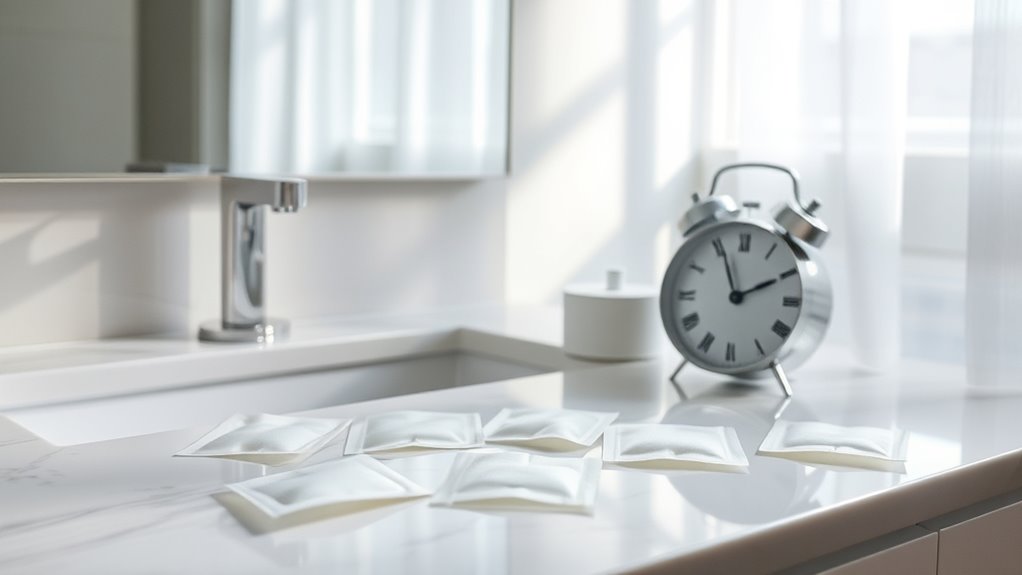
While pimple patches are often associated with short-term use, extended wear options can greatly enhance their effectiveness. You can usually wear them for 8 to 12 hours overnight, but some patches allow up to 24 hours for more severe breakouts.
These thinner, discreet patches absorb impurities over time, reducing inflammation and promoting healing. They also keep your skin protected from irritants, minimizing the risk of scarring by preventing picking. Plus, they help retain moisture, which is essential for skin health, as they create a moist environment that speeds up healing.
Extended wear is convenient, fitting seamlessly into your routine without frequent replacements. Just remember to monitor for saturation signs, as effective patches will turn white or become loose, indicating it’s time for a change.
Signs That Indicate Patch Replacement

Extended wear options can maximize the benefits of pimple patches, but knowing when to replace them is key to maintaining their efficacy. Look for signs like a saturated patch that’s turned opaque or white; this means it’s absorbed its maximum impurities. If the patch starts losing adhesion, peeling at the edges, it’s time for a change. You should also replace it if it lifts at the edges or becomes swollen, which can lead to skin irritation. Don’t forget to keep an eye on the recommended maximum wear time of 24 hours to maintain hygiene and effectiveness. Finally, if you notice reduced absorption, it’s definitely time to swap it out for a fresh patch. Remember, hydrocolloid material is designed to create a moist environment that helps draw out pus and oil, so replacing the patch when necessary is crucial for optimal results.
Matching Patches to Skin Types
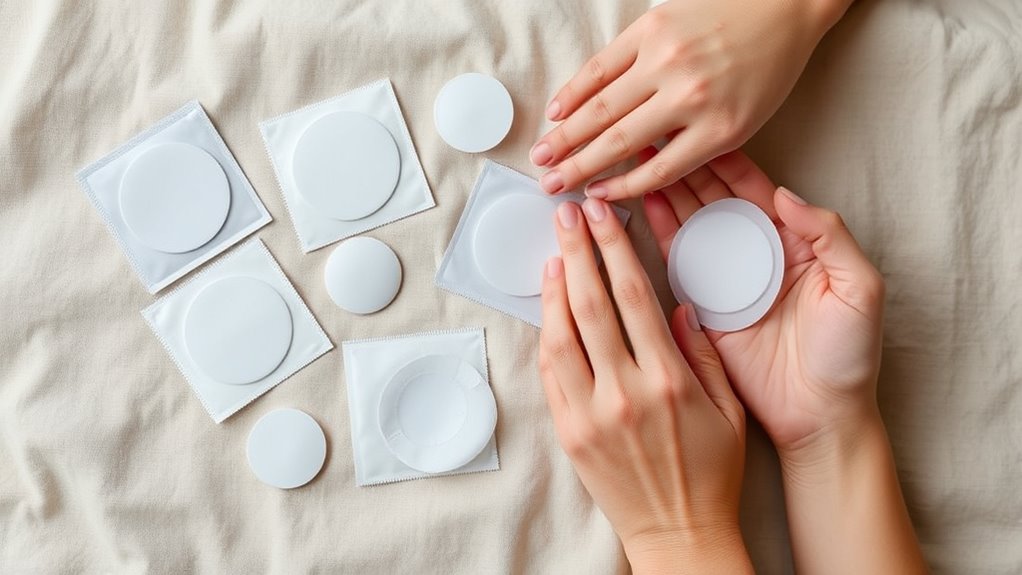
Choosing the right pimple patch can make all the difference in your skincare routine, especially when considering your skin type.
If you have oily skin, look for patches with sebum-regulating ingredients and lightweight designs that absorb excess oil. Hydrocolloid patches create an optimal healing environment by drawing out excess fluid and isolating wounds from external irritants.
For dry skin, choose patches containing hydrating ingredients like hyaluronic acid and gentle adhesives to prevent further dryness.
Sensitive skin types should opt for hypoallergenic, fragrance-free patches to minimize irritation.
If you have combination skin, select patches that balance oil control and moisture retention, possibly with versatile ingredients like niacinamide.
Always assess your skin’s needs and follow dermatologist recommendations to guarantee you’re using the best patches for your unique skin type.
The Effectiveness of Hydrocolloid Patches
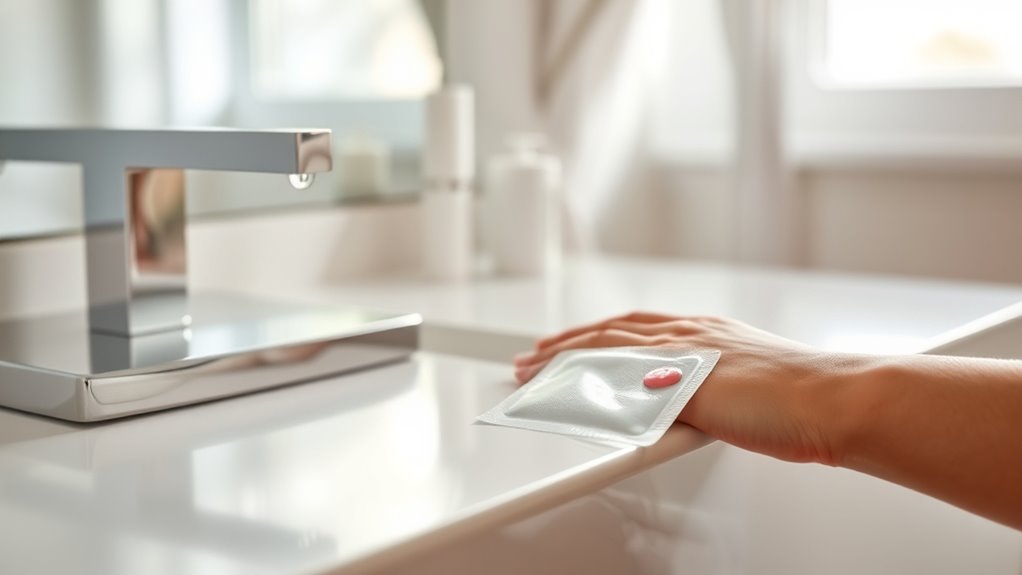
Hydrocolloid patches are a popular choice for treating pimples due to their ability to effectively reduce inflammation and promote healing.
They work best on open, surface-level pimples, quickly absorbing fluid and pus, which helps shrink their size. By creating a moist environment, these patches protect your skin while speeding up the healing process. The patches are composed of various materials that help in absorbing the infected fluid while providing a barrier against bacteria.
You can often see results within hours or overnight, providing relief from pesky breakouts. They also shield your skin from external irritants like UV and pollution.
However, keep in mind that they’re less effective for cystic or deep acne. For ideal results, make sure to apply them on clean, open pimples and replace them when they become saturated.
Differences Between Hydrocolloid and Microneedle Patches

While both hydrocolloid and microneedle patches aim to treat acne, they differ markedly in their materials and mechanisms.
Hydrocolloid patches use a gel-like material that absorbs excess fluids, making them ideal for surface-level blemishes like whiteheads. They create a protective barrier, reducing inflammation and preventing picking. Additionally, hydrocolloid patches absorb excess oil and impurities, promoting faster healing of pustules.
In contrast, microneedle patches contain tiny dissolvable needles that penetrate the skin, delivering active ingredients directly to deeper, inflamed acne such as cysts. This targeted approach enhances absorption but can cause irritation, especially for sensitive skin.
While hydrocolloid patches are gentler, microneedle patches provide more intensive treatment. Both types promote healing and can reduce the risk of scarring, but choosing the right one depends on your specific acne needs.
Best Practices for Applying Pimple Patches
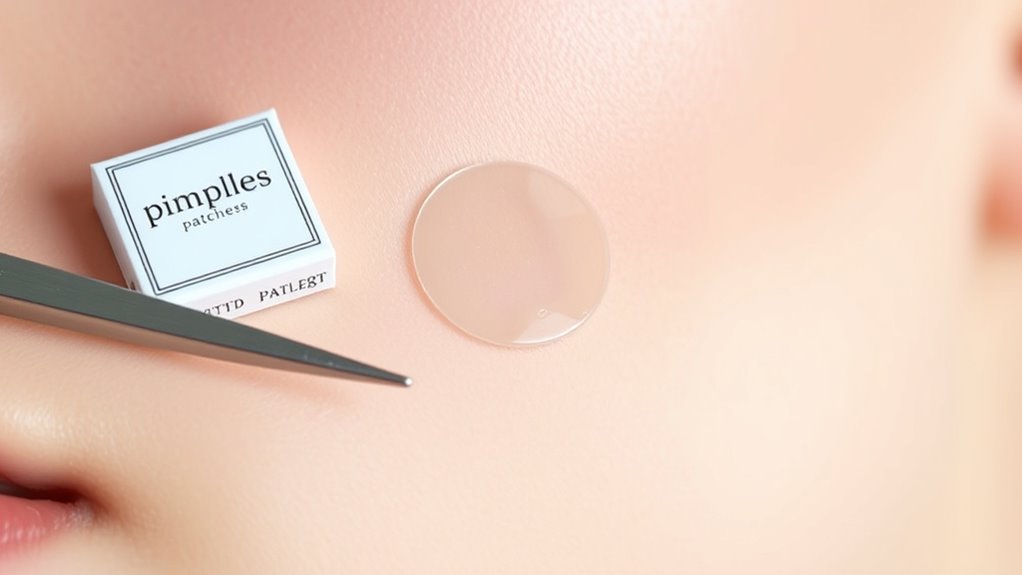
To achieve the best results with pimple patches, it’s essential to follow a few key practices during application.
First, cleanse the area thoroughly and make sure it’s completely dry to promote strong adhesion. Use gentle skincare products before application, avoiding oil-based items. Drying the area thoroughly ensures that moisture doesn’t weaken the patch’s adhesive properties.
Don’t forget to wash your hands to prevent transferring bacteria. When selecting a patch, choose one that fits the pimple and surrounding area, and consider options with salicylic acid or tea tree oil for extra benefits.
Apply the patch directly to the cleansed area, pressing and holding for 20-30 seconds. Ideally, leave the patch on overnight for ideal healing.
After removal, cleanse the area again to maintain skin health and consider reapplying as needed.
Limitations and Alternatives to Pimple Patches

Although pimple patches can be a handy solution for surface-level acne, they come with limitations that may leave you seeking alternatives.
They’re ineffective for deep, cystic acne and can cause skin irritation, especially if you have sensitive skin. Patches primarily address surface issues without tackling underlying causes, which might leave you frustrated. Covering pimples can even trap bacteria, worsening your condition. Instead, consider topical treatments like salicylic acid or benzoyl peroxide, or consult a dermatologist for oral medications. A thorough skincare routine can also help manage acne better. Additionally, many websites provide information on user consent management, which can help you understand how your data is handled when seeking skincare advice. Using products with hydrocolloid technology can also enhance the effectiveness of your acne treatment.
Pimple patches are effective for treating individual, surface-level pimples, but they do not address the broader issues of acne. Don’t forget about lifestyle factors like diet and stress, which play a significant role in your skin’s health. Explore these options for a more effective acne-fighting strategy.
Frequently Asked Questions
Can I Apply Makeup Over Pimple Patches?
Yes, you can definitely apply makeup over pimple patches!
Just make sure your skin is clean and dry before applying the patches. Opt for lightweight products, and use a matte finish concealer for better blending.
Gently apply your makeup to avoid displacing the patch. Remember to choose colors that counteract the patch’s hue for a seamless look.
This way, you can cover blemishes while protecting them from irritants.
How Often Can I Use Pimple Patches in a Week?
Using pimple patches can feel like having a secret weapon in your skincare arsenal.
You can use them daily if you’re battling ongoing breakouts, adjusting based on how severe your acne is. For stubborn spots, you might reach for patches more often.
Just keep an eye on your skin’s reaction; if irritation pops up, dial back the usage.
Always remember to follow the product instructions for the best results tailored to your skin.
Are Pimple Patches Suitable for Sensitive Skin?
Absolutely, pimple patches are suitable for sensitive skin!
They’re typically made from gentle hydrocolloid material, which won’t irritate your skin.
You’ll appreciate that many patches are hypoallergenic and free from harsh chemicals.
When you apply them, they retain moisture and absorb impurities, aiding your skin’s natural healing process.
Just remember to choose patches specifically designed for sensitive skin to minimize any risk of irritation or allergic reactions.
Your skin deserves that extra care!
Can I Use Pimple Patches on Open Wounds?
Imagine placing a soothing blanket over a sore spot; that’s what pimple patches do for open wounds.
You can use them on popped pimples, as they absorb fluid and promote healing. Just make sure the area’s clean before applying.
However, steer clear of infected wounds, since patches might trap bacteria and make things worse.
Change the patch regularly, especially if it’s saturated, to keep everything fresh and effective.
Do Pimple Patches Expire, and How Should They Be Stored?
Pimple patches can expire, especially those with active ingredients like salicylic acid, which come with an expiration date.
Hydrocolloid patches don’t technically expire but are best used within three to five years.
To keep them effective, store your patches in a cool, dry place away from sunlight, and avoid moisture.
Always check the packaging for expiration dates to guarantee you’re getting the most out of your patches without risking skin irritation.
Conclusion
To summarize, wearing pimple patches for the right amount of time can make all the difference. Stick to the ideal duration, usually 6 to 8 hours, and don’t be tempted to leave them on for too long—less is often more. If you notice signs that the patch needs changing, don’t hesitate to swap it out. By following best practices, you can tackle those pesky pimples effectively and get back to feeling your best in no time!






